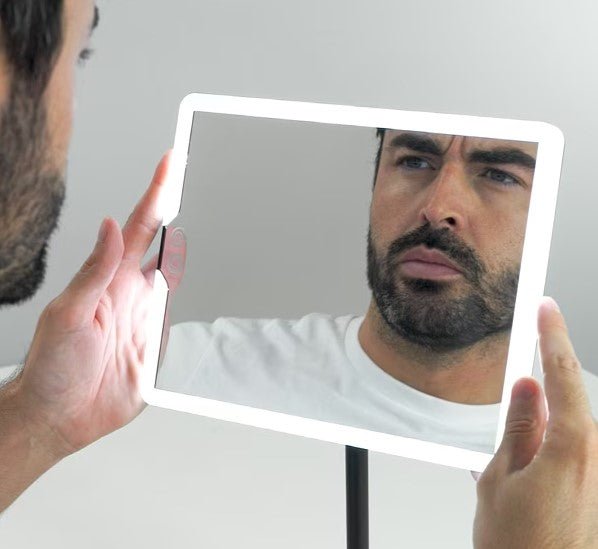Use a magnification mirror and LED modes to spot early skin sensitivity - redness, irritation and reactions - before they escalate. Stay ahead with mirror-backed checks.
Mirror-Based Ingredient Tracker: Spot Early Signs of Sensitivity or Reaction
You apply potent actives. You hope for glow. Sometimes you get irritation. A mirror-backed tracker catches early signs. A lighted magnifying mirror reveals redness under warm-glow LEDs. A daylight LED shows subtle tone shifts. Use magnification mirror zoom to see pinpoint irritation.
Why Early Detection Matters
Skin reactions can worsen quickly. You need feedback before a patch test fails in public. A vanity mirror with lights gives true color. A magnification mirror shows micro-irritations. You adjust product frequency. You avoid inflammation and downtime.
1. Redness Under Warm-Glow LED
LED Mode: Warm-glow. What to spot: Flat or patchy red areas. Technique: Use 5× magnification mirror. Inspect cheeks, forehead and jaw. Early redness often precedes itch or stinging.
2. Pinpoint Bumps in Cool-White
LED Mode: Cool-white. What to spot: Tiny raised bumps or uniform papules. Technique: Switch to 7× zoom on your led mirror. Focus on hairline and nose folds, common reaction zones.
3. Dry Patches in Daylight Mode
LED Mode: Daylight (5 500K). What to spot: Scaly, flaky spots that resist moisturizer. Technique: Use a compact mirror light to check under chin and jawline. Dry patches can signal over-exfoliation or barrier compromise.
4. Breakout Clusters vs Individual Pimples
Magnification: 5×. What to spot: Isolated whiteheads or clusters. Technique: Inspect under daylight LED with a magnification mirror. Clusters may indicate irritant dermatitis rather than acne.
5. Itchy Flare Signals
LED Mode: Cool-white. What to spot: Slight skin texture changes or bumps accompanied by itching. Technique: Use a travel mirror for midday checks. Itchy signals need immediate barrier repair: soothe with ceramides.
6. Pigment Swirls After Reaction
LED Mode: Daylight. What to spot: Light brown or pink spots lingering after redness. Technique: Photograph under consistent settings with a portable light mirror. Compare weekly to confirm fading or escalation.
7. Raised Vein or Blood Vessel Visibility
Magnification: 7×. LED Mode: Warm-glow. What to spot: Tiny capillaries or vessel prominence in cheeks and nose. Technique: Inspect under warm LED on your cosmetic light mirror. Persistent vessels may need professional treatment.
Feature Checklist
| LED Mode | Signal | Magnification |
|---|---|---|
| Warm-Glow | Early redness | 5× |
| Cool-White | Pinpoint bumps & itch | 7× |
| Daylight | Dry patches & pigment | 5× |
| Warm-Glow | Vein visibility | 7× |
Pro Tip
Keep a journal of mirror checks. Note date, LED mode, magnification and observations. Adjust your skincare routine based on documented patterns.
FAQ
Stay ahead of reactions. Shop our Compact 2.0 or Orbit Mirror for precise skincare tracking.



Leave a comment
This site is protected by hCaptcha and the hCaptcha Privacy Policy and Terms of Service apply.